2018 MV Agusta Turismo Veloce 800 Lusso SCS First Ride Review

Applying Rekluse clutch technology to MV's sport tourer
Fast luxury touring. That is, specifically, the translation of turismo veloce lusso. Add some numbers and acronyms and you have the long model designation of the motorcycle we would be riding in northern Italy near the MV Agusta factory in Varese, the 2018 MV Agusta Turismo Veloce 800 Lusso SCS.
2018 MV Agusta Turismo Veloce 800 Lusso SCS
| Engine | 18.5/20 |
| Suspension/Handling | 13.0/15 |
| Transmission/Clutch | 9.0/10 |
| Brakes | 9.5/10 |
| Instruments/Controls | 4.0/5 |
| Ergonomics/Comfort | 9.25/10 |
| Appearance/Quality | 9.0/10 |
| Desirability | 9.0/10 |
| Value | 7.0/10 |
| Overall Score | 88.25/100 |
MV Agusta would like to position the Turismo Veloce as a sport motorcycle on which you can ride all day or, with its two 30-liter side cases, pull light touring duty. A sport tourer? No, says MV Agusta CEO, Giovanni Castiglioni and Technical Director, Brian Gillen, a sportbike that you can ride all day or tour with. Hmm. Okay. I get it. The illustrious Italian marque doesn’t want their sportbike that you can ride all day or tour with being lumped into the same category as subjectively less sexy models such as the BMW 1200RT or Yamaha FJR. That’s cool, we’ll play ball… (whispers to self, I’m calling it a sport tourer in the subhead).
While the most buzz-worthy news from MV’s new model release is the introduction of its Smart Clutch System (SCS), which has been developed over the past two years in coordination with the American company, Rekluse (well-known for its use in off-road applications), it would be a disservice not to mention updates to the 2018 Turismo Veloce line as a whole. Many changes were due to Euro 4 requirements in emissions and sound reduction; however, there have also been updates put in place to address reliability issues – a problem which has unfortunately tarnished the brand’s image to a degree over the years. Will the new era of MV Agusta’s legacy be enough to silence the critics? Only time and miles will tell.
Taking some noise from here and adding sound there
Euro 4 requirements have forced manufacturers to not only reduce exhaust emissions by 50%, but to also reduce overall sound coming from the motorcycle. In order to reduce exhaust emissions to this level, it requires all manufacturers to undergo impressive engineering feats to not lose power. MV Agusta is pleased to announce that they have met these new standards without having an effect on performance numbers, claiming 110 hp at 10,150 rpm and 59 lb-ft of torque at 7,100 rpm. This was accomplished by reducing power losses between the combustion chamber and the rear wheel while focusing on energy losses rather than power losses.
As with exhaust emissions, noise reduction from Euro 3 to Euro 4 also required a 50% reduction. This includes sound from every aspect of the motorcycle; engine, exhaust, tires, and even the noise from wind buffeting over bodywork. With MV Agusta known for the scintillating sounds produced by its motorcycles, it forced the company to look at ways to reduce high-frequency noise substantially while focusing on tweaking, and in some cases adding, to the emotion-inducing soundtrack of its motorcycle’s intake and exhaust notes.
These requirements were achieved by a bevy of engine updates including new primary and oil pump drive gears, a revamped cylinder head in which the cam profiles and valves were re-engineered, new transmission gears have been used for smoother shifts, and a harmonic damper has also been added to the side of the engine to further reduce unwanted noise.
While speaking with Giovanni Castiglioni over dinner, he mentioned the company is thankful for the challenges Euro 4 has presented them with, causing MV Agusta to flex its engineering muscles to stay current and develop new systems and technologies to meet these stringent requirements.
Turismo Lusso
The Lusso designation gets you all kind of luxuries with touring in mind. Two 30-liter hard side cases are fantastically designed to be very close together, keeping the handlebar as the widest point of the motorcycle and offering enough storage for two XXL Arai Corsairs, according to MV. Also included on the Lusso models are heated grips and a center stand.
Perhaps the main attraction of the Lusso models is the semi-electronic Sachs suspension components which control damping both front and rear. Preload is still a manual adjustment located on the right fork leg for the front, and an easily adjusted knob on the rear. When switching through the four ride modes – Sport, Touring, Rain, and Custom – the damping settings are adjusted automatically. These parameters can be tweaked further using the bluetooth-connected app which is currently only available for iPhones, but should be ready for Android users ahead of the model’s expected delivery to the U.S. in September.
Also included in the app is the ability to download a data capture from your ride which will give maximum speed, lean angle, GPS coordinates, etc. giving those interested a more interactive experience with their bike. The onboard storage is said to record approximately four hours of data. After that, it begins to overlap upon itself.
The TFT display on the Turismo looks busy at a glance but only because it is basically showing you everything at one time. It was easy to become familiar with over a short period of time and is easily navigated via the left-side switchgear.
Tossing the Turismo into corners between our stints in traffic was effortless. Between the fantastic Brembo braking components, broad mid-range torque, and quick steering, the Turismo V is a whole lot of fun to ride veloce.
Smart Clutch System (SCS)
Now, let’s get into the new technology MV has brought to the market in collaboration with Rekluse. It’s not really new technology – Rekluse has been building these clutch components for 15 years – though, this is the first time we have seen it adapted to a street motorcycle straight from the factory. MV stated they have been working on perfecting this technology with Rekluse over the past two years.
While considering DCT and CVT systems that are currently on the market, MV Agusta opted to work in a different direction, dissatisfied by the complex and heavy componentry of DCT and lack of performance associated with CVT systems. MV’s idea of applying this concept is performance focused, so adding weight, up to 25-pounds in Honda’s most recent Africa Twin’s case, was not an option.
Brian Gillen, Mechanical Engineer & Technical Director at MV Agusta has spent plenty of time racing on- and off-road throughout the years and was the driving force behind looking to apply Rekluse technology into MV Agusta motorcycles.
The Rekluse system, coupled with MV’s Motor & Vehicle Integrated Control System (MVICS), provided a lightweight, low inertia, compact and tunable answer to the company’s search for an automatic clutch technology that has the right amount of sport and comfort.
Personally, the SCS application checks a lot of boxes for my preferences when considering an automatic transmission. I still want to be able to shift with my foot, and also having the option to slip the clutch with the lever was a nice touch, while only adding .08-pounds from the traditional clutch, making the SCS an incredibly interesting option now on the market. MV Agusta also mentioned there are already plans in place to expand on this technology as well as adapt it to other motorcycles in its lineup.
Our group of journalists was split in two with the opportunity to sample the SCS model in the morning, then switching to the standard Lusso model after lunch, which gave us a chance to test the system back-to-back, allowing for a thorough comparison.
First, we were given the chance to sample the SCS in the parking lot of MV Agusta’s lake-front Varese facility before being turned loose on public roads. Thankfully, it wasn’t difficult to get used to after spending time on the Zero DSR and Honda’s new Africa Twin Adventure Sport DCT model a few weeks ago. As mentioned before, the SCS gives you much more of the traditional feel of a standard clutch-equipped motorcycle, allowing you to use the clutch lever if necessary while still requiring you to shift with your foot as normal. While not being quite as smooth overall as Honda’s DCT application, it was hard to find much fault in the Rekluse RadiusCX-based system.
After listening to Gillen explain that the SCS will allow for a 3.15-second 0-100 kph, which is just .4 seconds off from some of the best WSBK start times, and on par with average take-offs in the series, I was looking forward to giving the Turismo full gas and seeing just what the 110hp 798cc Triple could do with MV’s new tech.
The Smart Clutch System centers around the vehicle control module which has allowed MV’s software engineers to look at front and rear wheel speed, which gear is engaged, engine rpm, and throttle position to control the torque electronically when applying it to the Rekluse clutch. Based on these variables, MV has developed an algorithm to apply torque in specific scenarios, controlling when the clutch begins to slip, how much it is slipping, when it engages and also on the reverse side of things when disengaging the clutch. The slipping upon disengagement might be specifically interesting to those who have used the Rekluse system previously as the clutch would “let go” causing a freewheeling effect when not under a torque load. With MV’s electronic torque control, this doesn’t happen as they have designed the system to control slip on disengagement as well, so there is never any freewheeling while slowing to a stop.
After spending half of the day on the SCS model, I was mostly impressed and the few issues I had with the system, in my opinion, are negligible when considering the potential use of this system. The quickshift up only works with the gas on and auto-blip downshifts only work with the gas off, which was easy enough to get used to. The quickshifting felt a little heavy, but not cumbersome, though I did have a few false neutrals trying to get back into first gear as well as one on the way to second. Of course, you can basically leave it in second and negate that issue entirely, if you should so choose.
Riding the standard model afterward, the quickshift up and auto-blip down were noticeably easier and more crisp. When slipping the clutch through traffic in the small Italian villages sprinkled throughout our route was the time when I most missed the SCS.
I thoroughly enjoyed my time on both Turismo Veloce 800 Lusso models. As mentioned previously, putting aside the two clutch options, the Turismo Veloce is a fantastic motorcycle. The semi-electronic suspension works well, though in Sport mode I might have liked to be able to stiffen the damping a bit more from the dash. Throttle response is crisp in Sport and smooth in Touring while the Rain setting cuts power to 70% (none of us were interested in cutting power during our ride with the constant need to pass traffic on our way to more sinuous asphalt). The sometimes abrupt throttle response I had noticed on the Brutale 800 from our 800cc Euro Triples Streetfighter Faceoff (you thought the Turismo’s model name was long) was nowhere to be found on this deliciously smooth turismo-er. The seat is wide and comfortable, which is also the opposite of my experience on the aforementioned Brute.
I would dare to say the 2018 MV Agusta Turismo Veloce 800 Lusso is one of the most refined motorcycles MV Agusta has ever made. With the Italian company acknowledging its service and reliability woes and taking steps to correct them, we may see a new era for MV Agusta. During dinner and our presentation, both Giovanni and Brian expressed that they understand the challenges the brand faces and are willing to swallow some of that Italian pride in order to bring MV Agusta back to prominence among high-end Italian sport motorcycles. The 2018 Turismo seems like a solid example of MV’s potential and the application of the SCS system shows the company is looking toward the future.
We should have some interesting models revealed at EICMA 2018 from MV Agusta as well as the unveiling of light electric motorcycles from Cagiva. Perhaps the Russian Comsar Investment is just what MV needed to streamline the company’s business plans for the future. Again, only time will tell, but I’m sure I’m not alone when looking forward to it.
In Gear

Helmet: AGV Sportmodular Tricolore $849.95
Jacket: Dainese D-Explorer Jacket $899.95
Pants: Dainese D-Explorer Pant $529.95
Boots: Dainese Torque D1 Out Gore-Tex $429.95
Gloves: Dainese Universe Gore-Tex $229.95
2018 MV Agusta Turismo Veloce 800 Lusso SCS
+ Highs
- Precise handling
- Smooth throttle response and torque delivery
- The inclusion of Rekluse technology is a mic drop in the current search for an auto trans solution
– Sighs
- Pricing puts it on par with Multistrada 1260s and other larger displaced motorcyclesPeople will complain about dealer network and reliabilityDifficult to get past neutral without using the clutch lever even with the SCS
- Pricing puts it on par with Multistrada 1260s and other larger displaced motorcycles
- People will complain about dealer network and reliability
- Difficult to get past neutral without using the clutch lever even with the SCS
2018 MV Agusta Turismo Veloce 800 Lusso SCS Specifications | |
|---|---|
| MSRP | $21,998 ($19,998 without SCS) |
| Engine Type | Three-cylinder, 4 stroke, 12 valve |
| Displacement | 798 cc |
| Horsepower | 108.6 hp at 10,150 rpm (claimed) |
| Torque | 59.0 lb-ft at 7,100 rpm (claimed) |
| Engine management | Integrated ignition – injection system MVICS 2.0, four engine maps and 8-level traction control |
| Transmission | 6-speed with MV EAS 2.0 (Electronically assisted Shift up & down) |
| Clutch | SCS (Smart Clutch System) Radius CX |
| Frame type | ALS Steel tubular trellis (MAG welded), aluminum alloy swingarm pivot plates |
| Front Suspension | 43mm Sachs inverted hydraulic fork, semi-active with MV Agusta Chassis Stability Control, 6.2 inches of travel |
| Rear Suspension | Progressive Sachs, single shock adsorber, semi-active with MV Agusta Chassis Stability Control, 6.5 inches of travel |
| Front Brake | 320 mm double floating disc, radial four-piston Brembo caliper |
| Rear Brake | 220 mm single steel disc, two-piston Brembo caliper |
| ABS | Bosch 9 Plus with rear wheel lift-up mitigation |
| Front Wheel | 3.5 x 17″ aluminum alloy |
| Rear Wheel | 6.0 x 17″ aluminum alloy |
| Front Tire | 120/70-ZR 17 M/C (58 W) |
| Rear Tire | 190/55-ZR17 M/C (75 W) |
| Wheelbase | 56.9 inches |
| Length | 83.7 inches |
| Width | 35.8 inches |
| Seat height | 33.5 inches |
| Ground clearance | 5.5 inches |
| Trail | 4.3 inches |
| Fuel tank capacity | 5.7 gallons |
| Dry weight | 423.2 pounds (claimed) |

Ryan’s time in the motorcycle industry has revolved around sales and marketing prior to landing a gig at Motorcycle.com. An avid motorcyclist, interested in all shapes, sizes, and colors of motorized two-wheeled vehicles, Ryan brings a young, passionate enthusiasm to the digital pages of MO.
More by Ryan Adams





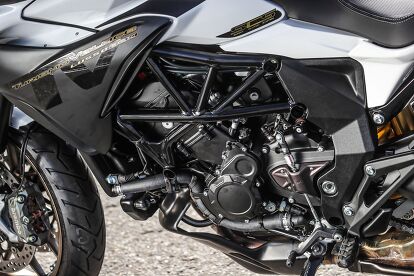






































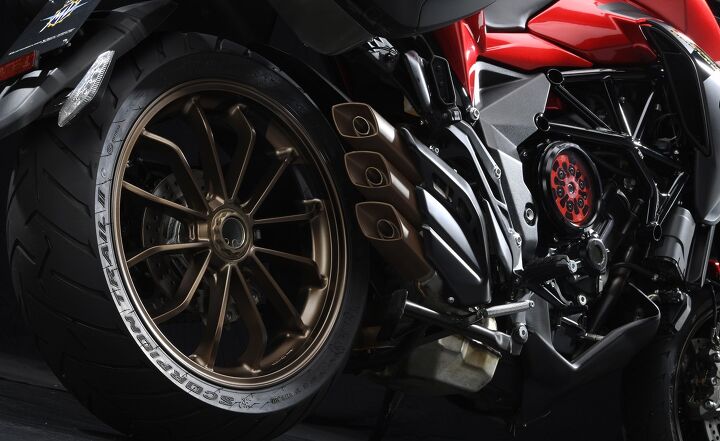























































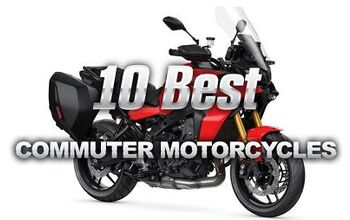









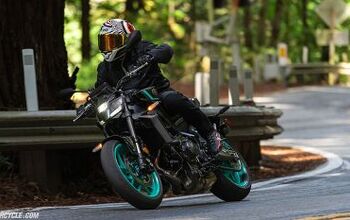




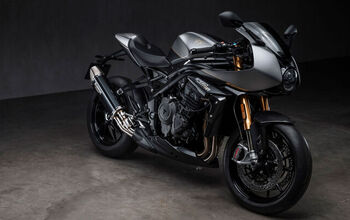


Comments
Join the conversation
Too expensive for me. Next.
I turned 60 this year and wanted to downsize from my MG Norge but not give up a lot. I was looking at 2016 Tourismos, and loved what I saw. The problem came when I sat on it. It could have been my height (6’ 2” w/ 34” inseam) but the seat slopes forward and I kept sliding toward the tank whenever I shifted position, even at a stop. That, and the fact there was no top box available, kept me from buying the bike. Having said that, I will be back at the dealer to check out the latest version. I would rather have the MV than a BMW GT800 or Honda VFR.